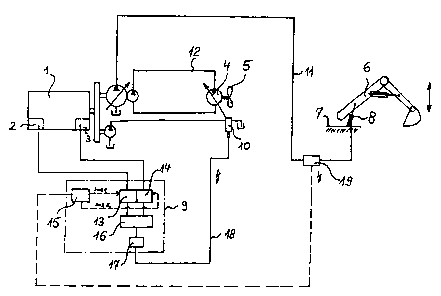Some of the information on this Web page has been provided by external sources. The Government of Canada is not responsible for the accuracy, reliability or currency of the information supplied by external sources. Users wishing to rely upon this information should consult directly with the source of the information. Content provided by external sources is not subject to official languages, privacy and accessibility requirements.
Any discrepancies in the text and image of the Claims and Abstract are due to differing posting times. Text of the Claims and Abstract are posted:
| (12) Patent Application: | (11) CA 2426452 |
|---|---|
| (54) English Title: | METHOD AND DEVICE FOR REGULATION OF A COOLING FAN DRIVE ON AN INTERNAL COMBUSTION ENGINE IN A CONSTRUCTION OR WORKING MACHINE |
| (54) French Title: | PROCEDE ET DISPOSITIF DE REGLAGE D'UN ENTRAINEMENT DE VENTILATEUR SUR UN MOTEUR A COMBUSTION INTERNE DANS DES MACHINES-OUTILS ET/OU MACHINES DE CONSTRUCTION |
| Status: | Deemed Abandoned and Beyond the Period of Reinstatement - Pending Response to Notice of Disregarded Communication |
| (51) International Patent Classification (IPC): |
|
|---|---|
| (72) Inventors : |
|
| (73) Owners : |
|
| (71) Applicants : |
|
| (74) Agent: | MACRAE & CO. |
| (74) Associate agent: | |
| (45) Issued: | |
| (86) PCT Filing Date: | 2001-09-05 |
| (87) Open to Public Inspection: | 2003-04-24 |
| Availability of licence: | N/A |
| Dedicated to the Public: | N/A |
| (25) Language of filing: | English |
| Patent Cooperation Treaty (PCT): | Yes |
|---|---|
| (86) PCT Filing Number: | PCT/EP2001/010193 |
| (87) International Publication Number: | WO 2002020955 |
| (85) National Entry: | 2003-04-24 |
| (30) Application Priority Data: | ||||||
|---|---|---|---|---|---|---|
|
The invention relates to a method for regulation of a cooling fan drive on an
internal combustion engine, in particular equipped with several independent
cooling circuits, in a construction or working machine, whereby the power
drain of the cooling fan drive is set to approximately zero during certain
working stages of the construction and/or working and said power drain may be
added to the capacity for the working stage.
L'invention concerne un procédé de réglage d'un entraînement de ventilateur sur un moteur à combustion interne, équipé en particulier de plusieurs circuits de refroidissement indépendants, dans des machines-outils et/ou machines de construction. Selon ce procédé, la consommation de l'entraînement de ventilateur est réglée à environ zéro à certains cycles de travail prédéfinis de la machine-outil et/ou machine de construction et cette consommation est ajoutée à la capacité relative au cycle de travail.
Note: Claims are shown in the official language in which they were submitted.
Note: Descriptions are shown in the official language in which they were submitted.

2024-08-01:As part of the Next Generation Patents (NGP) transition, the Canadian Patents Database (CPD) now contains a more detailed Event History, which replicates the Event Log of our new back-office solution.
Please note that "Inactive:" events refers to events no longer in use in our new back-office solution.
For a clearer understanding of the status of the application/patent presented on this page, the site Disclaimer , as well as the definitions for Patent , Event History , Maintenance Fee and Payment History should be consulted.
| Description | Date |
|---|---|
| Application Not Reinstated by Deadline | 2006-09-05 |
| Time Limit for Reversal Expired | 2006-09-05 |
| Deemed Abandoned - Failure to Respond to Maintenance Fee Notice | 2005-09-06 |
| Letter Sent | 2003-11-12 |
| Reinstatement Requirements Deemed Compliant for All Abandonment Reasons | 2003-10-24 |
| Deemed Abandoned - Failure to Respond to Maintenance Fee Notice | 2003-09-05 |
| Inactive: Cover page published | 2003-06-27 |
| Letter Sent | 2003-06-23 |
| Inactive: Notice - National entry - No RFE | 2003-06-23 |
| Application Received - PCT | 2003-05-22 |
| National Entry Requirements Determined Compliant | 2003-04-24 |
| Application Published (Open to Public Inspection) | 2003-04-24 |
| Abandonment Date | Reason | Reinstatement Date |
|---|---|---|
| 2005-09-06 | ||
| 2003-09-05 |
The last payment was received on 2004-08-24
Note : If the full payment has not been received on or before the date indicated, a further fee may be required which may be one of the following
Please refer to the CIPO Patent Fees web page to see all current fee amounts.
| Fee Type | Anniversary Year | Due Date | Paid Date |
|---|---|---|---|
| Basic national fee - standard | 2003-04-24 | ||
| Reinstatement (national entry) | 2003-04-24 | ||
| Registration of a document | 2003-04-24 | ||
| MF (application, 2nd anniv.) - standard | 02 | 2003-09-05 | 2003-10-24 |
| Reinstatement | 2003-10-24 | ||
| MF (application, 3rd anniv.) - standard | 03 | 2004-09-07 | 2004-08-24 |
Note: Records showing the ownership history in alphabetical order.
| Current Owners on Record |
|---|
| TEREX GERMANY GMBH & CO. KG |
| Past Owners on Record |
|---|
| HERBERT ZIPLIES |
| UWE ESCH |